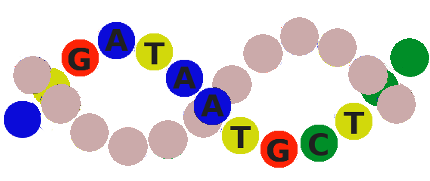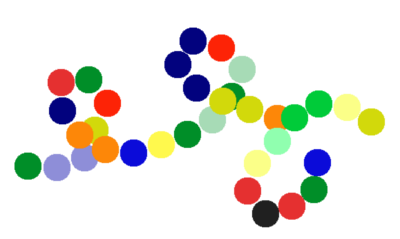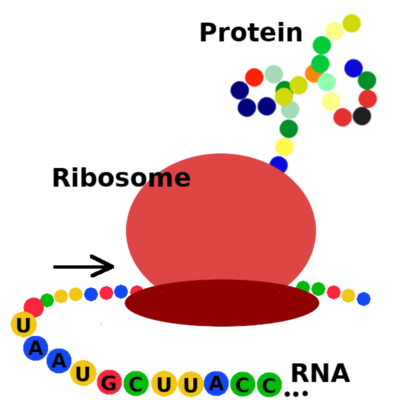DNA is crucial molecule for the life on Earth - it encodes the instructions for building of all proteins which create and direct (enzymes) our body. How DNA actually works?
DNA and proteins are chains of moleculesDNA is a long chain composed of four different molecules, which we assigned letters A, T, G, C to - according to the scientific names of these molecules: Adenine, Thymine, Guanine a Cytosine. DNA usually makes a double-helix, in which one strand is entwisted by another one so that each "A" is opposited to "T" (and vice-versa) , and each "G" is oppostited to "C" (end vice-versa).
Similarily, also aminoacids in proteins are denoted by letters. In this case, there are totaly 22 different molecules (letters), so there is almost all (latin) alphabet, except the letters "B", "J, "X", and "Z". Every protein is thus one chain of these 22 letters twisted around itself by different ways.


The sequence of DNA letters encodes the sequence of protein
Despite of the letters of DNA are different molecules than protein letters, they instruct the cell, which particular aminoacid (protein letter) has to be on particular position within protein. How it is possible when DNA consists of only 4 different letters (molecules) and there are 22 letters in proteins? It is due to the cipher nature of DNA: every three letters in DNA (so called "codon") encode one letter in the protein. We can count that there is 4 * 4 * 4 = 64 different combinations of DNA letters in codon, therefore that DNA can "cipher" for 64 different aminoacids. It is more than enough and so majority aminoacids is encoded by two or more different codons in DNA.
| DNA | ... | GAT | AAT | GCT | ... |
| Protein | ... | D | N | A | ... |
The begining is marked by "M" and surrounding sequences
If the instruction for protein production are encoded by triplets (codons) of letters, how the cell knows which letter to start from? After all, DNA can be divided into triplets by 3 different manners and each of them can encode completely different protein::
| 1st possibility | ...GAT AAT GCT... |
| 2nd possibility | ...G ATA ATG CT... |
| 3rd possibility | ...GA TAA TGC T... |
In the cells, the majority of proteins begin by aminoacid Methionine, which is encoded by one only codon - ATG. This letter "M" can be, of course, in any other position in protein, so how the cell recognize which "M" is the starting? Correct START-codon is usually preceded by another specific sequence of DNA letters, which indicating the next "M" is the starting one.
The end is delimited by STOP-codon
Not all of 64 possible codons encode for some aminoacid in protein. Three of them, particularly TAA, TGA and TAG serves as so-called STOP-codons: they do not encode any aminoacids and production of protein stops when they are reached. In special limited cases, however, cells can encode aminoacids selenocysteine (letter "U") or pyrrolysine (letter "O") instead of "TGA" or "TAG" STOP-codons, respectively.
DNA cipher is "translated" on ribosomes
In the program DNA encoder, the cipher is encoded/decoded by computer - how it is done in the cell, however? In the cell, there are special composed molecules called ribosomes, which create protein according to DNA cipher. As they "translate" information from genetic code into protein "language", this process is called translation. Furthermore - in order not to be such a simple - ribosomes cannot work with DNA. Therefore, the sequences being translated (genes) have to be "copied" into RNA first - the molecule similar to DNA but having letter "U" (Uracil) instead of "T". This process is called transcription.

In contrast to our encoding program, cells can work in only one direction: "DNA -> RNA -> protein" and cannot make DNA according to a protein sequence.

